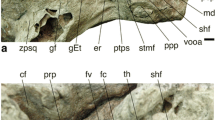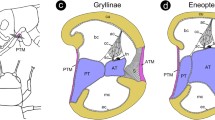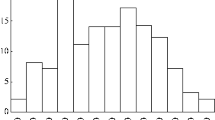Summary
The morphology of the complex tibial organs in the forelegs of two bushcricket species belonging to the Phaneropterinae and Decticinae (Tettigoniidae) is described comparatively. In both species the tibial organs are made up of the subgenual organ, the intermediate organ and the crista acustica; the latter are parts of the tympanal organs and serve as auditory receptors. The very thin tympana in the forelegs ofPholidoptera griseoaptera (Decticinae) are protected by tympanal covers whereas inLeptophyes punctatissima (Phaneropterinae) the tympana are thicker and fully exposed. The overall auditory sensitivity ofL. punctatissima is lower and the sensitivity maximum of the hearing threshold lies at higher frequencies compared toP. griseoaptera. The number of scolopidia in the three scolopale organs and the dimensions of parts of the sound conducting system differs in the two species. In the crista acustica ofL. punctatissima a higher number of scolopidia is distributed in a smaller range than inP. griseoaptera; the scolopidia are especially concentrated in the distal part. Morphometrical analyses indicate that the dimensions of the spiracles, the acoustic trachea and the tympana determine the overall auditory sensitivity and that the arrangement of the scolopidia and the dimensions of structures in the crista acustica affect the frequency tuning of the hearing threshold.
Similar content being viewed by others
References
Bailey WJ (1990) The ear of the bushcricket. In: Bailey WJ, Rentz DCF (eds) The tettigoniidae: biology, systematics and evolution. Crawford House Press, Bathurst, pp 217–247
Heinrich R, Jatho M, Kalmring K (1993) Acoustic transmission characteristics of the tympanal tracheae of bushcrickets (Tettigoniidae). II: Comparative studies of the tracheae of seven species. J Acoust Soc Am 93:3481–3489
Heller KG (1988) Bioakustik der europäischen Laubheuschrekken. Verlag Josef Margraf, Weikersheim
Jatho M, Weidemann S, Kretzen D (1992) Species-specific sound production in three ephippigerine bushcrickets. Behav Proc 26:31–42
Kalmring K, Lewis B, Eichendorf A (1978) The physiological characteristics of the primary sensory neurons of the complex tibial organ ofDecticus verrucivorus L (Orthoptera, Ensifera). J Comp Physiol 127:109–121
Kalmring K, Rössler W, Ebendt R, Ahi J, Lakes R (1993) The auditory organs in the forelegs of bushcrickets: physiology, receptor cell arrangement, and morphology of the tympanal and intermediate organs of three closely related species. Zool Jb Physiol 97:75–94
Lewis DB (1974) The physiology of the tettigoniid ear. I–IV. J Exp Biol 60:821–869
Michelsen A, Larsen ON (1978) Biophysics of the ensiferan ear. I. Tympanal vibrations in bushcrickets (Tettigoniidae) studied with laser vibrometry. J Comp Physiol 123:193–203
Mothes-Wagner U, Wagner G, Reitze HK, Seitz KA (1984) A standardized technique for the in toto epoxy resin embedding and precipitate-free staining of small specimens covered by strong protective outer surfaces. J Microsc 134:307–313
Oldfield BP (1982) Tonotopic organization of auditory receptors in Tettigoniidae (Orthoptera: Ensifera). J Comp Physiol 147:461–469
Robinson DJ, Rheinlaender J, Hartley JC (1986) Temporal parameters of male-female sound communication inLeptophyes punctatissima. Physiol Entomol 11:317–323
Rössler W (1992a) Postembryonic development of the complex tibial organ in the foreleg of the bushcricketEphippiger ephippiger (Orthoptera, Tettigoniidae). Cell Tissue Res 269:505–514
Rössler W (1992b) Functional morphology and development of tibial organs in the legs I, II and III of the bushcricketEphippiger ephippiger (Insecta, Ensifera). Zoomorphology 112:181–188
Schumacher R (1975) Scanning-electron-microscope description of the tibial tympanal organ of the Tettigonioidea (Orthoptera, Ensifera). Z Morphol Tiere 81:209–219
Schumacher R (1979) Zur funktionellen Morphologie des auditiven Systems der Laubheuschrecken (Orthoptera: Tettigonioidea). Entomol Gener 5:321–356
Spurr AR (1969) A low viscosity epoxy resin embedding medium for electron microscopy. J Ultrastruct Res 26:31–43
Author information
Authors and Affiliations
Rights and permissions
About this article
Cite this article
Rössler, W., Hübschen, A., Schul, J. et al. Functional morphology of bushcricket ears: comparison between two species belonging to the Phaneropterinae and Decticinae (Insecta, Ensifera). Zoomorphology 114, 39–46 (1994). https://doi.org/10.1007/BF00574913
Received:
Issue Date:
DOI: https://doi.org/10.1007/BF00574913




